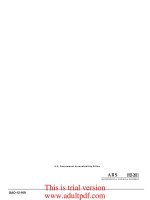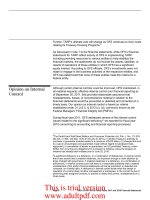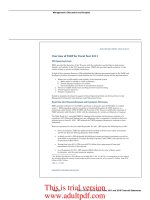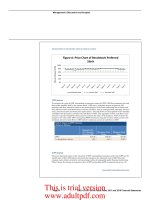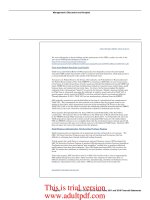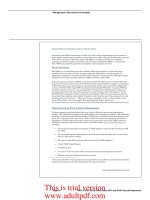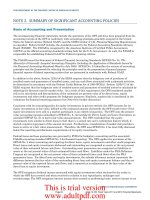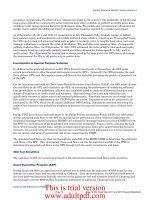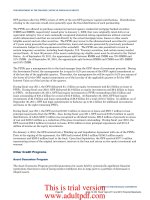United States Government Accountability Office GAO November 2011_part1 pot
Bạn đang xem bản rút gọn của tài liệu. Xem và tải ngay bản đầy đủ của tài liệu tại đây (241.76 KB, 10 trang )
Report to Congressional Committees
United States Government Accountabilit
y
Office
GAO
FINANCIAL AUDIT
November 2011
Office of Financial
Stability (Troubled
Asset Relief Program)
Fiscal Years 2011 and
2010 Financial
Statements
GAO-12-169
This is trial version
www.adultpdf.com
United States Government Accountability Office
Highlights of GAO-12-169, a report to
congressional committees
November 2011
FINANCIAL AUDIT
Office of Financial Stability (Troubled Asset Relief
Program) Fiscal Years 2011 and 2010 Financial
Statements
Why GAO Did This Study
On October 3, 2008, the Emergency
Economic Stabilization Act of 2008
(EESA) was signed into law. EESA
authorized the Secretary of the
Treasury to implement the Troubled
Asset Relief Program (TARP) and
established the Office of Financial
Stability (OFS) within the Department
of the Treasury (Treasury) to do so.
EESA requires the annual preparation
of financial statements for TARP, and
further requires GAO to audit these
statements.
GAO audited OFS’s fiscal years 2011
and 2010 financial statements for
TARP to determine whether, in all
material respects, (1) the financial
statements were fairly presented, and
(2) OFS management maintained
effective internal control over financial
reporting. GAO also tested OFS’s
compliance with selected provisions of
laws and regulations.
What GAO Recommends
GAO is not making recommendations
in this report, but will be reporting
separately on the control issues
identified during its audit.
In commenting on a draft of this report,
OFS concurred with GAO’s audit
finding concerning a significant
deficiency in its accounting and
financial reporting processes and
expressed its commitment to correcting
the deficiency.
What GAO Found
In GAO’s opinion, OFS’s fiscal years 2011 and 2010 financial statements for
TARP are fairly presented in all material respects. GAO also concluded that,
although internal controls could be improved, OFS maintained, in all material
respects, effective internal control over financial reporting as of September 30,
2011. GAO found no reportable noncompliance in fiscal year 2011 with the
provisions of laws and regulations it tested.
As of September 30, 2011 and 2010, net assets related to TARP direct loans,
equity investments, and the asset guarantee program had an estimated value of
about $80.8 billion and $145.5 billion, respectively. In addition, for fiscal years
2011 and 2010, OFS reported total net cost of operations of $9.5 billion
(including estimated subsidy cost of $7.2 billion) and total income from
operations of $23.1 billion (including estimated subsidy income of $24.2 billion),
respectively. The estimated net cost of TARP transactions from inception through
September 30, 2011, was $28.0 billion. In valuing TARP direct loans, equity
investments, and asset guarantee program, OFS management considered and
selected assumptions and data that it believed provided a reasonable basis for
the estimated subsidy costs (income) reported in the financial statements.
However, these assumptions and estimates are inherently subject to substantial
uncertainty arising from the likelihood of future changes in general economic,
regulatory, and market conditions. The estimates have an added uncertainty
arising from the unique nature of certain TARP assets. As such, there will be
differences between the net estimated values of the direct loans, equity
investments, and asset guarantee program, and the amounts that OFS will
ultimately realize from these assets, and such differences may be material.
These differences will also affect TARP’s ultimate cost.
During fiscal year 2011, OFS addressed several of the internal control issues
related to the significant deficiency GAO reported for fiscal year 2010 concerning
its accounting and financial reporting processes. However, the remaining control
issues along with other control deficiencies in this area that GAO identified in
fiscal year 2011 collectively represent a continuing significant deficiency in OFS’s
internal control over its accounting and financial reporting processes. While this
deficiency is not considered a material weakness, it merits the attention of those
charged with governance of OFS. GAO will be separately reporting to OFS on
additional details regarding this significant deficiency along with
recommendations for corrective actions.
View GAO-12-169. For more information,
contact Gary T. Engel at (202) 512-3406 or
This is trial version
www.adultpdf.com
Page i GAO-12-169
Contents
Transmittal Letter 1
Auditor’s Report 7
Opinion on Financial Statements 8
Opinion on Internal Control 9
Compliance with Laws and Regulations 11
Consistency of Other Information 11
Objectives, Scope, and Methodology 11
Agency Comments 13
Management’s Discussion and Analysis 14
Financial Statements 56
Balance Sheet 58
Statement of Net Cost
59
Statement of Changes in Net Position 60
Statement of Budgetary Resources 61
Notes to the Financial Statements 62
Appendix I Management’s Report on Internal Control over Financial Reporting 100
Appendix II Comments from the Office of Financial Stability 101
This is a work of the U.S. government and is not subject to copyright protection in the
United States. The published product may be reproduced and distributed in its entirety
without further permission from GAO. However, because this work may contain
copyrighted images or other material, permission from the copyright holder may be
necessary if you wish to reproduce this material separately.
OFS's Fiscal Years 2011 an
d 2010 Financial Statements
This is trial version
www.adultpdf.com
OFS's Fiscal Years 2011 an
d 2010 Financial Statements
United States Government Accountability Office
Washington, DC 20548
November 10, 2011
Congressional Committees
The accompanying auditor’s report presents the results of our audit of the
fiscal years 2011 and 2010 financial statements of the Office of Financial
Stability (Troubled Asset Relief Program). The Emergency Economic
Stabilization Act (EESA) of 2008
1
that authorized the Troubled Asset
Relief Program (TARP) on October 3, 2008, requires that TARP, which is
implemented by the Office of Financial Stability (OFS),
2
annually prepare
and submit to Congress and the public audited fiscal year financial
statements that are prepared in accordance with generally accepted
accounting principles.
3
EESA further requires that GAO audit TARP’s
financial statements annually.
4
We are also required under EESA to
report at least every 60 days on the findings resulting from our oversight
of the actions taken under TARP.
5
This report responds to both of these
requirements.
This report contains our (1) unqualified opinion on OFS’s fiscal years
2011 and 2010 financial statements for TARP; (2) opinion that, although
certain controls could be improved, OFS maintained, in all material
respects, effective internal control over financial reporting as of
September 30, 2011; and (3) conclusion that our tests of OFS’s
compliance with selected provisions of laws and regulations for fiscal year
2011 disclosed no instances of noncompliance. The accompanying report
1
Pub. L. No. 110-343, Div. A, 122 Stat 3765 (Oct. 3, 2008), codified in part, as amended,
at 12 U.S.C. §§ 5201-5261.
2
Section 101 of EESA, 12 U.S.C. § 5211, established OFS within the Department of the
Treasury (Treasury) to implement TARP.
3
Section 116(b) of EESA, 12 U.S.C. § 5226(b).
4
Section 116(b) of EESA, 12 U.S.C. § 5226(b).
5
Section 116 of EESA, 12 U.S.C. § 5226, requires the Comptroller General to report at least
every 60 days, as appropriate, on findings resulting from oversight of TARP, including its
performance in meeting the act’s purposes; the financial condition and internal controls of
TARP, its representatives, and agents; the characteristics of asset purchases and the
disposition of acquired assets, including any related commitments entered into; TARP’s
efficiency in using the funds appropriated for its operations; its compliance with applicable
laws and regulations; its efforts to prevent, identify, and minimize conflicts of interest among
those involved in its operations; and the efficacy of its contracting procedures.
Page 1 GAO-12
-169
This is trial version
www.adultpdf.com
also provides an overview of a continuing significant deficiency
6
in OFS’s
internal control over financial reporting that we believe merits the attention
of those charged with governance of OFS. We will be reporting separately
to OFS on more detailed information concerning this significant deficiency
along with recommended corrective actions.
Since its inception, OFS has initiated a broad range of activities under
TARP. Specific initiatives have included injecting capital into key financial
institutions, implementing programs to address problems in securitization
markets, providing assistance to the automobile industry and American
International Group, Inc. (AIG), and offering incentives for modifying
residential mortgages. These initiatives are described in more detail in the
footnotes to OFS’s financial statements and Management’s Discussion
and Analysis included in this report.
On December 9, 2009, the Secretary of the Treasury extended the
authorities to purchase and guarantee troubled assets under EESA
through October 3, 2010.
7
However, the Dodd-Frank Wall Street Reform
and Consumer Protection Act (Dodd-Frank Act), which was signed into
law on July 21, 2010, set a reduced limit on aggregate TARP purchases
and guarantees, and prohibited OFS from incurring any obligations for
6
A significant deficiency is a deficiency, or combination of deficiencies, in internal control
that is less severe than a material weakness, yet important enough to merit attention by
those charged with governance. A material weakness is a deficiency, or combination of
deficiencies, in internal control such that there is a reasonable possibility that a material
misstatement of the entity’s financial statements will not be prevented, or detected and
corrected, on a timely basis. A deficiency in internal control exists when the design or
operation of a control does not allow management or employees, in the normal course of
performing their assigned functions, to prevent, or detect and correct, misstatements on a
timely basis.
7
Section 120 of EESA, 12 U.S.C. § 5230, established that the authorities to purchase
troubled assets under Section 101(a)(1)-(2) and to guarantee troubled assets under Section
102 shall terminate on December 31, 2009. Section 120 of EESA further established that the
Secretary of the Treasury, upon submission of a written certification to Congress, may extend
the authority provided under these sections of EESA to expire no later than 2 years from the
date of the enactment of EESA (October 3, 2008). On December, 9, 2009, the Secretary
provided written certification to extend these EESA authorities to October 3, 2010.
Page 2 GAO-12
-169
OFS's Fiscal Years 2011 an
d 2010 Financial Statements
This is trial version
www.adultpdf.com
TARP programs that were not initiated prior to June 25, 2010.
8
During
fiscal year 2011, as OFS continued to wind down its activities, it focused
principally on managing remaining investments and helping homeowners
avoid preventable foreclosures.
As of September 30, 2011 and 2010, OFS reported net assets related to
TARP direct loans, equity investments, and the asset guarantee program
of $80.8 billion and $145.5 billion, respectively, which is net of a subsidy
cost allowance of $42.3 billion and $36.7 billion, respectively. The subsidy
cost allowance represents the difference between the amounts paid by
OFS for the direct loans and equity investments and the reported value of
such assets. In addition, for fiscal years 2011 and 2010, OFS reported
total net cost of operations of $9.5 billion (including estimated subsidy
cost of $7.2 billion) and total income from operations of $23.1 billion
(including estimated subsidy income of $24.2 billion), respectively.
9
The
estimated net cost of TARP transactions from inception through
September 30, 2011, was $28.0 billion. This net cost primarily consists of
net subsidy costs on direct loans and/or equity investments in automobile
companies and AIG, partially offset by the net subsidy income related to
TARP’s bank support and credit market programs.
OFS management considered and selected assumptions and data that it
believed provided a reasonable basis for the estimated costs reported in
the financial statements. However, these assumptions and estimates are
inherently subject to substantial uncertainty arising from the likelihood of
future changes in general economic, regulatory, and market conditions.
8
Under EESA, OFS was authorized to purchase troubled assets with an aggregate
purchase price of up to $700 billion outstanding at any one time, less offsets for
outstanding asset guarantees. The Dodd-Frank Wall Street Reform and Consumer
Protection Act, Pub. L. No. 111-203, title XIII, § 1302, 124 Stat. 1376, 2133 (July 21,
2010), (1) limited Treasury’s authority to purchase or guarantee troubled assets to a
maximum of $475 billion; (2) changed this limit to a cap on all purchases and guarantees
made without regard to subsequent sale, repayment, or cancellation of assets or
guarantees; and (3) prohibited Treasury, under EESA, from incurring any obligations for a
program or initiative unless the program or initiative had already been initiated prior to
June 25, 2010.
9
The subsidy cost/income is composed of (1) the change in the subsidy cost allowance,
net of write-offs; (2) net intragovernmental interest cost; (3) certain inflows from the direct
loans and equity investments (e.g., dividends, interest, net proceeds from sales and
repurchases of assets in excess of cost, and other realized fees); and (4) the change in
the estimated discounted net cash flows related to other credit programs (asset guarantee
program and Federal Housing Administration refinance program).
Page 3 GAO-12
-169
OFS's Fiscal Years 2011 an
d 2010 Financial Statements
This is trial version
www.adultpdf.com
The estimates have an added uncertainty arising from the unique nature
of certain TARP assets. As such, there will be differences between the
net estimated values of the direct loans, equity investments, and asset
guarantee program as of September 30, 2011 and 2010, and the
amounts that OFS will ultimately realize from these assets, and such
differences may be material. These differences will also affect TARP’s
ultimate cost. Further, TARP’s ultimate cost will change as OFS continues
to incur costs relating to its Treasury Housing Programs.
We are sending copies
of this report to the Secretary of the Treasury;
Assistant Secretary for Financial Stability; Financial Stability Oversight
Board; Acting Special Inspector General for TARP; Director of the Office
of Management and Budget; interested congressional committees and
members; and others. In addition, the report is available at no charge on
the GAO website at .
If you have questions about this report, please contact me at (202) 512-
3406 or
v. Contact points for our Offices of Congressional
Gary T. Engel
Relations and Public Aff
airs may be found on the last page of this report.
Director
gement and Assurance
Financial Mana
Page 4 GAO-12
-169
OFS's Fiscal Years 2011 an
d 2010 Financial Statements
This is trial version
www.adultpdf.com
List of Committees
The Honorable Daniel K. Inouye
Chairman
The Honorable Thad Cochran
Vice Chairman
Committee on Appropriations
United States Senate
The Honorable Tim Johnson
Chairman
The Honorable Richard C. Shelby
Ranking Member
Committee on Banking, Housing, and Urban Affairs
United States Senate
The Honorable Kent Conrad
Chairman
The Honorable Jeff Sessions
Ranking Member
Committee on the Budget
United States Senate
The Honorable Max Baucus
Chairman
The Honorable Orrin G. Hatch
Ranking Member
Committee on Finance
United States Senate
The Honorable Harold Rogers
Chairman
The Honorable Norman D. Dicks
Ranking Member
Committee on Appropriations
House of Representatives
The Honorable Paul Ryan
Chairman
The Honorable Chris Van Hollen
Ranking Member
Committee on the Budget
House of Representatives
Page 5 GAO-12
-169
OFS's Fiscal Years 2011 an
d 2010 Financial Statements
This is trial version
www.adultpdf.com
The Honorable Spencer Bachus
Chairman
The Honorable Barney Frank
Ranking Member
Committee on Financial Services
House of Representatives
The Honorable Dave Camp
Chairman
The Honorable Sander Levin
Ranking Member
Committee on Ways and Means
House of Representatives
Page 6 GAO-12
-169
OFS's Fiscal Years 2011 an
d 2010 Financial Statements
This is trial version
www.adultpdf.com
Page 7 GAO-12-169
United States Government Accountability Office
Washington, DC 20548
OFS's Fiscal Years 2011 an
d 2010 Financial Statements
To the Assistant Secretary for Financial Stability
In accordance with the Emergency Economic Stabilization Act of 2008
(EESA),
1
we are required to audit the financial statements of the Troubled
Asset Relief Program (TARP), which is implemented by the Office of
Financial Stability (OFS).
2
In our audit of OFS’s financial statements for
TARP for fiscal years 2011 and 2010, we found
the financial statements are presented fairly, in all material respects,
in conformity with U.S. generally accepted accounting principles;
although internal controls could be improved, OFS maintained, in all
material respects, effective internal control over financial reporting as
of September 30, 2011; and
no reportable noncompliance in fiscal year 2011 with provisions of
laws and regulations we tested.
The following sections discuss in more detail (1) these conclusions; (2)
our conclusion on OFS Management’s Discussion and Analysis (MD&A)
and other required supplementary and other accompanying information;
(3) our audit objectives, scope, and methodology; and (4) OFS’s
comments on a draft of this report. In addition to our responsibility to audit
OFS’s annual financial statements for TARP, we also are required under
EESA to report at least every 60 days on the findings resulting from our
oversight of the actions taken under TARP.
3
This report responds to both
1
Section 116(b) of EESA, 12 U.S.C. § 5226(b), requires that the Department of the Treasury
(Treasury) annually prepare and submit to Congress and the public audited fiscal year
financial statements for TARP that are prepared in accordance with generally accepted
accounting principles. Section 116(b) further requires that GAO audit TARP’s financial
statements annually in accordance with generally accepted auditing standards.
2
Section 101 of EESA, 12 U.S.C. § 5211, established OFS within Treasury to implement
TARP.
3
Section 116 of EESA, 12 U.S.C. § 5226, requires the Comptroller General to report at least
every 60 days, as appropriate, on findings resulting from oversight of TARP, including its
performance in meeting the act’s purposes; the financial condition and internal controls of
TARP, its representatives, and agents; the characteristics of asset purchases and the
disposition of acquired assets, including any related commitments entered into; TARP’s
efficiency in using the funds appropriated for its operations; its compliance with applicable
laws and regulations; its efforts to prevent, identify, and minimize conflicts of interest among
those involved in its operations; and the efficacy of its contracting procedures.
This is trial version
www.adultpdf.com
